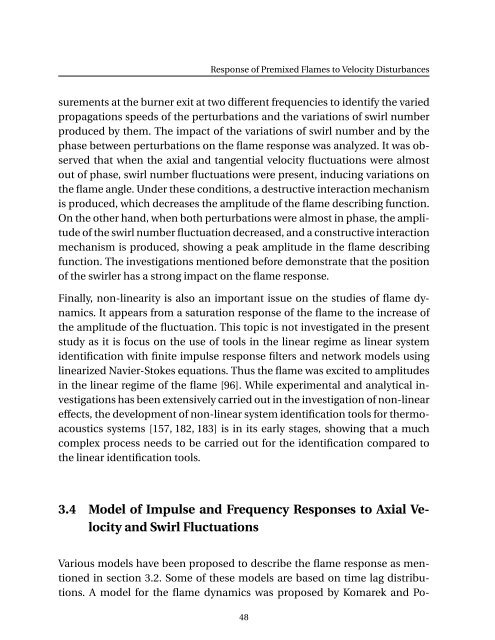Numerical Simulation of the Dynamics of Turbulent Swirling Flames
Numerical Simulation of the Dynamics of Turbulent Swirling Flames
Numerical Simulation of the Dynamics of Turbulent Swirling Flames
You also want an ePaper? Increase the reach of your titles
YUMPU automatically turns print PDFs into web optimized ePapers that Google loves.
Response <strong>of</strong> Premixed <strong>Flames</strong> to Velocity Disturbances<br />
surements at <strong>the</strong> burner exit at two different frequencies to identify <strong>the</strong> varied<br />
propagations speeds <strong>of</strong> <strong>the</strong> perturbations and <strong>the</strong> variations <strong>of</strong> swirl number<br />
produced by <strong>the</strong>m. The impact <strong>of</strong> <strong>the</strong> variations <strong>of</strong> swirl number and by <strong>the</strong><br />
phase between perturbations on <strong>the</strong> flame response was analyzed. It was observed<br />
that when <strong>the</strong> axial and tangential velocity fluctuations were almost<br />
out <strong>of</strong> phase, swirl number fluctuations were present, inducing variations on<br />
<strong>the</strong> flame angle. Under <strong>the</strong>se conditions, a destructive interaction mechanism<br />
is produced, which decreases <strong>the</strong> amplitude <strong>of</strong> <strong>the</strong> flame describing function.<br />
On <strong>the</strong> o<strong>the</strong>r hand, when both perturbations were almost in phase, <strong>the</strong> amplitude<br />
<strong>of</strong> <strong>the</strong> swirl number fluctuation decreased, and a constructive interaction<br />
mechanism is produced, showing a peak amplitude in <strong>the</strong> flame describing<br />
function. The investigations mentioned before demonstrate that <strong>the</strong> position<br />
<strong>of</strong> <strong>the</strong> swirler has a strong impact on <strong>the</strong> flame response.<br />
Finally, non-linearity is also an important issue on <strong>the</strong> studies <strong>of</strong> flame dynamics.<br />
It appears from a saturation response <strong>of</strong> <strong>the</strong> flame to <strong>the</strong> increase <strong>of</strong><br />
<strong>the</strong> amplitude <strong>of</strong> <strong>the</strong> fluctuation. This topic is not investigated in <strong>the</strong> present<br />
study as it is focus on <strong>the</strong> use <strong>of</strong> tools in <strong>the</strong> linear regime as linear system<br />
identification with finite impulse response filters and network models using<br />
linearized Navier-Stokes equations. Thus <strong>the</strong> flame was excited to amplitudes<br />
in <strong>the</strong> linear regime <strong>of</strong> <strong>the</strong> flame [96]. While experimental and analytical investigations<br />
has been extensively carried out in <strong>the</strong> investigation <strong>of</strong> non-linear<br />
effects, <strong>the</strong> development <strong>of</strong> non-linear system identification tools for <strong>the</strong>rmoacoustics<br />
systems [157, 182, 183] is in its early stages, showing that a much<br />
complex process needs to be carried out for <strong>the</strong> identification compared to<br />
<strong>the</strong> linear identification tools.<br />
3.4 Model <strong>of</strong> Impulse and Frequency Responses to Axial Velocity<br />
and Swirl Fluctuations<br />
Various models have been proposed to describe <strong>the</strong> flame response as mentioned<br />
in section 3.2. Some <strong>of</strong> <strong>the</strong>se models are based on time lag distributions.<br />
A model for <strong>the</strong> flame dynamics was proposed by Komarek and Po-<br />
48
















